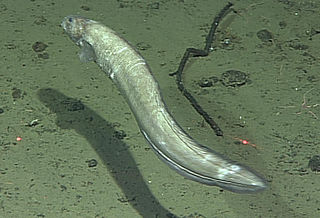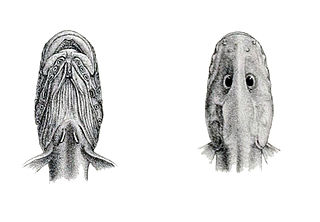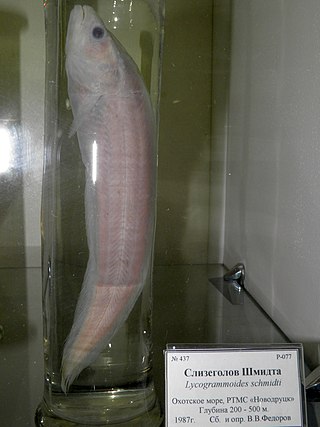The eelpouts are the ray-finned fish family Zoarcidae. As the common name suggests, they are somewhat eel-like in appearance. All of the 300 species are marine and mostly bottom-dwelling, some at great depths. Eelpouts are predominantly found in the Northern Hemisphere. The Arctic, north Pacific and north Atlantic oceans have the highest concentration of species; however, species are found around the globe.
Aiakas is a genus of marine ray-finned fishes belonging to the family Zoarcidae the eelpouts. These fishes are found in the southwestern Atlantic Ocean.

Bothrocara is a genus of marine ray-finned fishes belonging to the family Zoarcidae, the eelpouts. They are found in the Pacific Ocean with one species reaching the southwestern Atlantic Ocean.

Pachycara is a genus of marine ray-finned fishes belonging to the family Zoarcidae, the eelpouts. The fishes in this genus are found in the Atlantic, Indian, Southern and Pacific Ocean.
Petroschmidtia is a genus of marine ray-finned fishes belonging to the family Zoarcidae, the eelpouts. The species in this genus are placed in the genus Lycodes by FishBase but Catalog of Fishes recognises this as a valid genus.
Lycodes is a genus of zoarcid fish in the subfamily Lycodinae. It is the most species-rich genus in its taxonomic family as well as in the Arctic Ocean and adjacent waters. They occupy both shallow waters and deeper waters down to 3000 meters. A few species can occur in brackish waters.

Lycodichthys is a genus of marine ray-finned fish belonging to the family Zoarcidae, the eelpouts. They are found in the Southern Ocean.
Andriashevia is a monospecific genus of marine ray-finned fish belonging to the subfamiy Gymnelinae of the family Zoarcidae, the eelpouts, its only species is Andriasheevia aptera. It is found in the northwestern Pacific Ocean, where it occurs off the Pacific coast of Japan. It appears to be a demersal fish which is associated with large red gorgonian corals, e.g. Paragorgia. Examinations of the stomach contents of collected specimens has shown that its diet is mainly crustaceans but it likely also feeds on encrusting invertebrates which it searches for among coral branches and the hard substrates they live in. This species attains a maximum published standard length of 19.3 cm (7.6 in). Unlike other species in the subfamily Gymnelinae, this taxon has no pectoral fins. The genus name honours the Soviet ichthyologist Anatoly Petrovich Andriashev for his work on fishes of the Russian Far East and especially eelpouts. The specific name, aptera means "without wings" and refers to the absence of pectoral fins.
Lycodinae is a subfamily of marine ray-finned fish belonging to the family Zoarcidae, the eelpouts. These eelpouts are found are in all the world's oceans, with a number of species being found off southern South America.

Austrolycus is a genus of marine ray-finned fishes belonging to the family Zoarcidae, the eelpouts. The two species in this genus are found in the southeastern Pacific Ocean and the western South Atlantic Ocean off southern South America and the Falkland Islands.
Bothrocarina is a genus of marine ray-finned fishes belonging to the family Zoarcidae, the eelpouts. The two species in this genus are found in the Northwestern Pacific Ocean.
Dieidolycus is a genus of marine ray-finned fishes belonging to the family Zoarcidae, the eelpouts. The genus comprises three species which are found in the western central Pacific, southeastern Pacific and Southern Oceans.
Japonolycodes is a monospecific genus of marine ray-finned fish belonging to the family Zoarcidae, the eelpouts. The only species in the genus is Japonolycodes abei. This species is found Northwestern Pacific Ocean off Japan.

Lycenchelys muraena, the moray wolf eel, is a species of marine ray-finned fish belonging to the family Zoarcidae, the eelpouts. It is found in the Arctic and North Atlantic Oceans.
Lycodapus is a genus of marine ray-finned fishes belonging to the family Zoarcidae, the eelpouts. The species in this genus are found in the Pacific and Southern Oceans.
Lycodonus is a genus of marine ray-finned fish belonging to the family Zoarcidae, the eelpouts. The species in this genus are found in the North and Southern Atlantic Ocean. These fishes are sometimes called scutepouts.

Lycogrammoides is a monospecific genus of marine ray-finned fish belonging to the family Zoarcidae, the eelpouts. Its only species is Lycogrammoides schmidti, a rare species of the Sea of Okhotsk in the northwestern Pacific Ocean.
The bearded eelpout is a species of marine ray-finned fish belonging to the family Zoarcidae, the eelpouts. This species is the only species in the monospecific genus Lyconema. It is found in the eastern Pacific Ocean.
Ophthalmolycus is a genus of marine ray-finned fishes belonging to the family Zoarcidae, the eelpouts. Its two species are found in the southwestern Atlantic Ocean and the Southern Ocean.
Lycozoarces is a monospecific genus of marine ray-finned fish belonging to the family Zoarcidae, the eelpouts, its only species being Lycozoarces regani. It is the only genus in the monogeneric subfamily Lycozoarinae. This taxon occurs in the northwestern Pacific Ocean in the Sea of Okhotsk and the Tatar Strait in the northern Sea of Japan.







